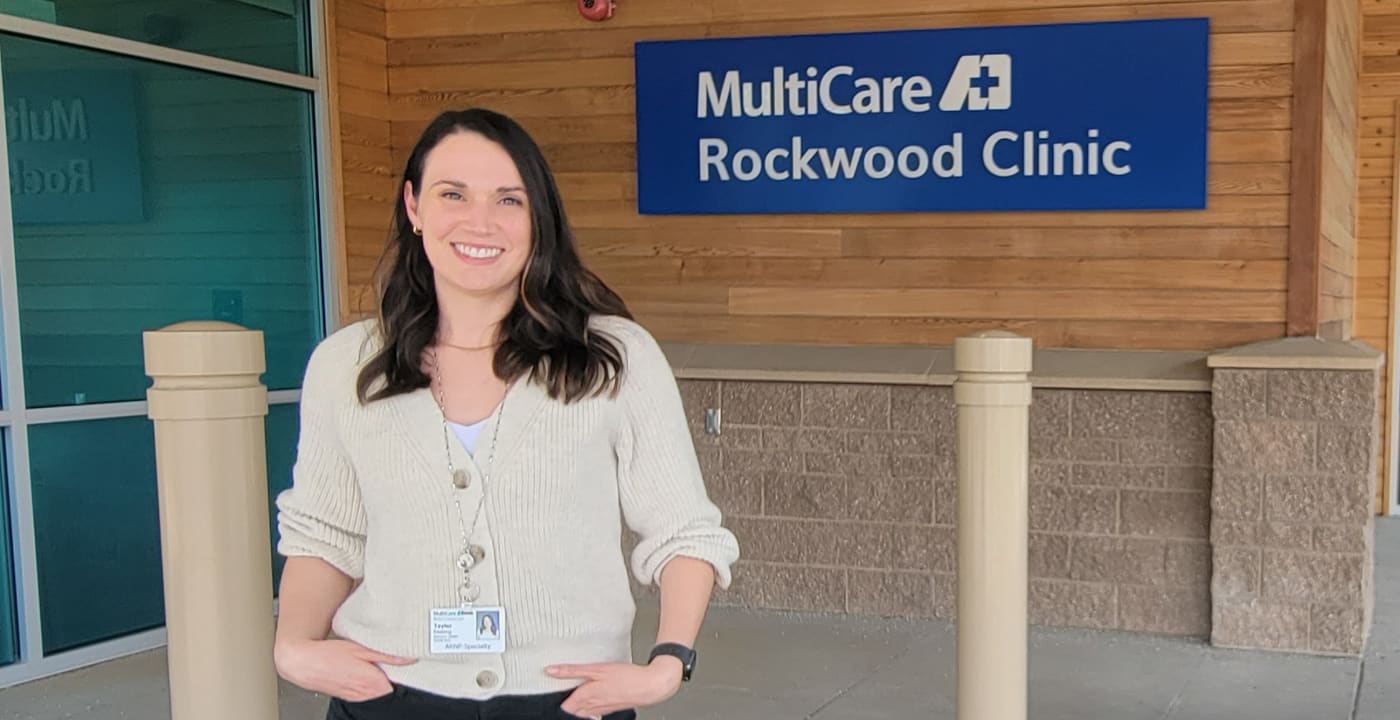Relationships matter in mental health care

When someone walked into the MultiCare Rockwood Clinic Quail Run location earlier this year and told the front desk they were having thoughts of suicide, staff turned to Taylor Keating, ARNP.
As a psychiatric mental health nurse practitioner embedded in the clinic, Keating assessed the situation and had the person transported to the closest emergency department.
Luckily for everyone, Keating happened to be available and says she’s glad the clinic could help, even as a non-emergency location.
About four years ago, the Rockwood Clinic behavioral health team relocated from their clinic at MultiCare Deaconess Hospital and embedded their providers in primary care locations across the region. The move allowed for a more seamless patient experience and enhanced collaboration with primary care providers.
Here’s a day in Keating’s life caring for patients as a behavioral health provider.
A full schedule
Keating typically comes in early to catch up on messages and prepare for the day’s appointments. Once her day begins, it’s nonstop.
Most days include two 60-minute intake appointments with new patients and as many 30-minute follow-up appointments she can schedule.
Follow-ups involve checking in with patients, their care plans and medications. They’re either in-person or virtual, depending on what patients are being seen for and their ability to make it to the clinic. Many must travel across town or farther because there are only three MultiCare behavioral health providers in the Inland Northwest.
Today’s schedule was half virtual.
“With therapy, you’re following up either every week or every other week, and that’s a lot on a person and their schedule, so having this option has been a game changer,” Keating says. “If a patient has a sick kid, or something comes up but they can have a phone call, we do that. That’s not always a luxury other specialties have.”
We don’t want things to slip through the cracks when it comes to mental health, she says, so it’s most important to see patients in a timely manner. Ultimately it comes down to the patient — they get what they put into mental health treatment, she adds.
Building relationships
Keating conducts all new patient intakes in person so she can get a good feel for the person and their condition and begin building a trusting relationship. She describes that first appointment as an “interview” of herself, too.
“I try to get them comfortable and to not make mental health treatment this big, scary thing. I don’t wear the white jacket and I don’t keep a lot of clinical stuff in my office,” she says. “I love when I can win over somebody’s previous negative experience with mental health treatment … and give them hope that’s not how it’s supposed to be and won’t be from now on.”
Developing a good therapeutic relationship is important to Keating — it ensures she’s doing the best she can for her patients, that they’re getting what they need and they feel heard and respected. If a patient doesn’t feel that, she encourages them to advocate for themselves and find a better fit.
When the relationship does work, though, great things can happen.
Keating recalls one patient she saw earlier in the day who had been a no-show for months. In those months out of treatment, their mental health declined, and shortly into the appointment they shared that they’d been preparing to take their life.
“How I react in that moment can make or break the rest of their view on mental health treatment. To just sit there and talk through it with them … and to show them that opening up is not a scary thing, but a good first step,” she says. “We took time to lay out a safety plan and what options were reasonable for them right now. They work and have financial restrictions to seeking care, so we have to understand that full piece of it, too.”
Mental health isn’t a straight path
Some patients struggle to get care because of life circumstances or challenging systems, Keating acknowledges.
“It’s tough for those living paycheck to paycheck, and you have to respect patient autonomy,” she says. “Some choose that this isn’t the right time, and that can also be a necessary part of their treatment journey.”
Sometimes, though, it’s necessary to share her outside perspective and suggest that “maybe it’s worth investing the time, finances and energy to focus on this now, not later, so you can reenter life as it was with more tools and a better approach,” Keating says.
“I love when I can win over somebody’s previous negative experience with mental health treatment … and give them hope that’s not how it’s supposed to be and won’t be from now on.”
There are also factors outside everyone’s control, she explains. In the case of her patient expressing suicidal ideations, they’d been struggling to get their prescription medications over the past month due to a national stimulant shortage and changing insurance providers.
“Sometimes the health care system as a whole makes you want to hit your head against a wall. … I think every provider is dealing with that right now. Everyone is trying to find something to help,” Keating says. “Those are the frustrating things, but they have a solution somehow, some way. But in the case of this patient, that will keep me up at night.”
The COVID-19 pandemic played a significant role in medication shortages, as there’s been an increase in ADHD diagnoses, she explains. For many people, coping skills they developed to adapt to the dramatic shifts to daily life suddenly don’t work anymore.
There’s also been an increase in anxiety, especially in social settings.
“When the pandemic hit and we stayed home, there was a lot of anxiety and depression, which became the new normal. Now there’s a lot of fear of going into social settings,” Keating says. “Particularly with that group of kids in high school who missed out on junior and senior year and now are in college — there’s a lot of developmental stages that got missed.”
Self-care is a universal need
Keating says it’s important to remind her patients and herself that there will be ups and downs, and that’s OK. She’s developed her own routines to decompress.
“You have to develop a mindfulness routine to shut down after the day. After I drive to pick up my daughter from day care, I sit in the car for two minutes and breathe and remind myself, ‘This is time for you and your family,’” she says. “I know my patients still have access to care after I leave if they need, and I need to take care of myself, too, so I can be there for them.”
Even on the hardest days, Keating says she’s never felt she chose the wrong profession.
“I love what I do, and it makes the challenge worth it,” she says. “When you find a treatment plan that’s working and patients can start doing the things that help maintain that, like being more social and active, applying for that scary job or leaving that unhealthy relationship, that’s my favorite.”




